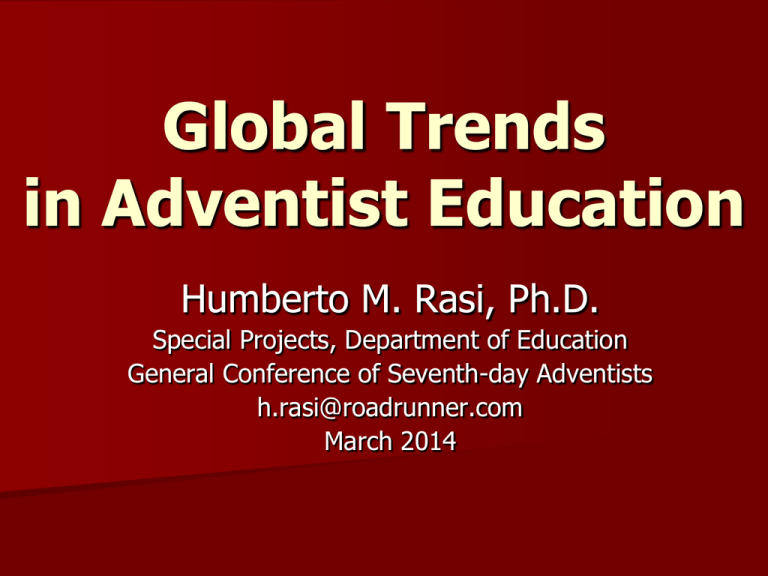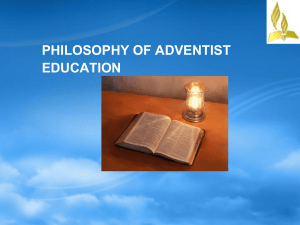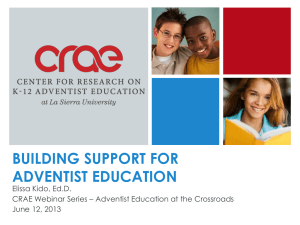Strengthening Adventist Identity and Mission in Adventist Education
advertisement

Global Trends in Adventist Education Humberto M. Rasi, Ph.D. Special Projects, Department of Education General Conference of Seventh-day Adventists h.rasi@roadrunner.com March 2014 Preliminary reflection “The Christian mind [is] a mind trained, informed, equipped to handle data of secular controversy within a framework of reference which is constructed of Christian presuppositions. The Christian mind is a prerequisite of Christian thinking. And Christian thinking is the prerequisite of Christian action. “To think secularly is to think within a frame of reference bounded by the limits of our life on earth…. To think Christianly is to accept all things with the mind as related, directly or indirectly, to man’s eternal destiny as the redeemed and chosen child of God.” Harry Blamires, The Christian Mind: How Should A Christian Think, Servant Books, 1978, pp. 43, 44 In this presentation we will… Present current statistics of our global educational system Acknowledge the leading voice that set the conceptual foundation and projected the vision of Adventist education Summarize the core characteristics of the Adventist brand of education Examine five encouraging trends and five trends that should concern us regarding the status and future of Adventist education (I am aware of the risks of this outline…) Outline 9 factors that can strengthen the identity and mission of Adventist academies, colleges and universities My perspective: Student, academy teacher and vice-principal, department chair, graduate dean, world education director, university board member, father of a college department chair/teacher, father/grandfather of students in our schools Gratitude A global phenomenon The pioneers who formally launched Adventist education in 1872 would be amazed if they could see the reach of that initiative now, 142 years later From a one-room school that met above the living quarters of the teacher—Goodloe Harper Bell—in Battle Creek, Michigan, that tentative project has become a truly global enterprise Today, on a regular school day… In 7,900 schools, academies, and colleges/universities 90,000 teachers and educational administrators Are forming the lives and future of 1.8 million students In more than 109 countries of the world Seventh-day Adventist Education World Statistics - December 31, 2011 Schools Teachers Students Primary 5,815 44,356 1,084,665 Secondary 1,908 32,481 521,041 Training 48 631 8,397 Tertiary 112 11,595 136,548 Totals 7,883 89,063 1,750,651 A leading voice From the beginning, the leading voice in providing the conceptual foundation and projecting the vision of Adventist education was a woman who did not have extensive formal school but who was well read and aware of education– Ellen Harmon White (1827-1915) In her short essay (“Proper Education” 1872-1873), later expanded in Education (1903) and Counsels to Parents, Teachers, and Students (1913), she outlined a counter-cultural, practical philosophy and mission for Adventist education, quite ahead of her time Her counsel deals not only with elementary and secondary schools, but also with our fledgling tertiary institutions such as Battle Creek and Avondale College Challenges then and now In spite of Ellen White’s counsel, the first steps in the journey of Adventist education were uncertain The story of those challenges, ups-and-downs, and zigzags has been told by historians such as Floyd Greenleaf, George Knight, Gary Land, and others Limited human resources, perennial financial difficulties, disagreements regarding purpose, scope, and methods as well as with management and accreditation--part of that saga that continues today A century ago Frederick Griggs provided clearer curricular focus and stronger organizational structure We can thank God for His guidance: Our educational system continues to expand, although unevenly The Adventist brand of education Has a broader and deeper scope than education as commonly understood by our secular peers It seeks to form whole persons—mind, will, body, relationships It is anchored on the biblical worldview and is centered in Christ—our Creator, Savior, and Lord It fosters independent thought and positive action It prepares youth for a noble and useful life on this planet and also for life eternal with God It conveys to students the knowledge, values, skills, and attitude needed to provide quality service It forms thoughtful leaders of character for Adventist mission and for the betterment of society at large Encouraging global trends –1 1. Overall growth during recent decades in Adventist educational centers, tertiary programs, and student enrollment The expansion in general follows membership growth, but continues to lag behind proportional increase in all countries of the world For example, schools of medicine: Loma Linda, Mexico, Argentina, Nigeria, Peru… Growth occurs at a lower pace in the older Adventist centers (in a few cases, retrenchment) and a bit faster in countries where Adventism is younger and poorer Let’s examine the following charts… Seventh-day Adventist Education Educational Institutions by Decade Primary 4,463 4,045 4,127 4,267 4,809 5,815 309 398 806 887 1,126 1,908 Training 0 0 0 32 35 48 Tertiary 51 77 76 76 94 112 Totals 4,823 4,520 5,009 5,262 6,064 7,883 1960 1970 1980 1990 2000 2011 Secondary Seventh-day Adventist Education Institutional Growth by Decade - by Level 6,000 Primary Secondary Tertiary Training 5,000 Institutions 4,000 3,000 2,000 1,000 0 1960 1970 1980 1990 Year 2000 2011 Seventh-day Adventist Education Institutional Growth by Decade - Total 8,000 Institutions 7,000 6,000 5,000 4,000 1960 1970 1980 1990 Year 2000 2011 Seventh-day Adventist Education Student Enrollment by Decades - by Level Primary Secondary Tertiary Worker Training Student Enrollment 1,000,000 750,000 500,000 250,000 0 1960 1970 1980 1990 Year 2000 2011 Seventh-day Adventist Education Student Enrollment by Decades - Total 1,800,000 Student Enrollment 1,500,000 1,200,000 900,000 600,000 300,000 0 1960 1970 1980 1990 Year 2000 2011 Seventh-day Adventist Education Student Enrollment by Decade - Total 1,800,000 Student Enrollment 1,500,000 1,200,000 900,000 600,000 300,000 0 1960 1970 1980 1990 Year 2000 2011 Encouraging global trends –2 2. Increasing recognition of the value of Adventist education by government authorities, employers, and families of other faiths National authorities continue to encourage and authorize new Adventist tertiary institutions Students graduating from our professional programs (business, education, nursing…) are eagerly sought for their values and skills Dr. Kido’s study revealed the amazing results of NAD Adventist primary/jr high schools in student success In some countries, we influence public education Hindu and Moslem families choose our schools Encouraging global trends – 3 3. Renewed school emphasis at all levels on the biblical-Christian formation of students Crucial to form the next generation of Adventists who will embrace our beliefs and carry on our mission Many institutions seek to improve the quality of Bible/Religion courses; implement a Spiritual Master Plan; sponsor weeks of spiritual emphases, appoint qualified chaplains Some educational centers implement a deliberate process of integrating faith/values with teaching/learning, involving both faculty and staff More resources, manuals, and tools: CIRCLE, Institute for Christian Teaching, AUP, Adventus Books Encouraging global trends – 4 4. Growing attention to the service dimension of Adventist education and to mission/outreach at home and abroad God has placed us on this world to serve and help alleviate needs of fellow human beings— hope in Jesus, health, literacy, construction Our schools: ideal opportunity for adolescents & young adults to embrace active compassion Many schools include a service component in their programs; focus on one region or country Frequently students take the initiative; connect theory and practice; learn by doing Encouraging global trends – 5 5. Realization that Adventist educational centers form leaders and that their faculty play the role of thinking with/for the church We continue to train essential leaders for Adventist organizations, local churches, and society at large Marked expansion of master’s thesis and doctoral dissertations prepared in our institutions and by other Adventist graduate students in public universities Yet, slow increase in the number of research-based publications by Adventist scholars/authors; we must move from consumers to creators of ideas Our faculty, centers, and institutes help the church to think, articulate, strategize, and plan for the future Brief interaction in groups of 2 or 3 ● Please turn to one or two of your colleagues ● Review, discuss, and evaluate the five encouraging trends outlined 1. Overall growth in institutions/students 2. Increased recognition value SDA educ. 3. Renewed emphasis on Christian formtn. 4. Growing attention to service/mission 5. Realization: form leaders, church thinks ● On target? Applicable to your school/territory? ● Additional positive global trends? Nuances? Trends that should concern us -1 1. Dramatic decline in students-to-members ratios, particularly among Adventists As Adventism expands --especially in Africa, Asia, Latin America– there is a growing gap between the number of members and the number of students enrolled in our educational centers In 1960, 23 students in Adventist schools per 100 members; in 2000 only 9, half of them Adventists Stagnation or retrenchment in some countries Various factors: weaker commitment, costs, competing public/private schools and programs, imbalance between evangelism and nurture See charts and graphs… Seventh-day Adventist Education Adventist Students to Members Ratio - by Decade Adventist Students Church Membership 16,000,000 Individuals 12,000,000 8,000,000 4,000,000 0 1960 1970 1980 1990 Year 2000 2011 Trends that should concern us -2 2. The impact of the surrounding culture is weakening the Adventist identity and mission of our educational centers Values of secular culture are diametrically opposed to the goals of Adventist schools; we must resist them Factor: Steady decrease in the proportion of Adventist teachers in secondary/tertiary institutions Factor: Increase in the proportion of students from other faiths or no faith, frequently not well managed Factor: Decline in the number of boarding students Secular thinking of some faculty, erosion of Adventist behavioral standards, attraction of other models History: All church-founded universities have severed ties with their church roots and become secularized Seventh-day Adventist Education Percentage of Adventist Students Enrolled (1996-2011) - by Level Primary 42 41 41 41 46 46 38 53 43 43 40 40 44 45 44 41 Secondary 51 46 48 43 42 35 43 39 40 38 37 34 36 37 41 40 Training 65 90 63 56 80 51 57 61 52 51 48 47 49 49 53 44 Tertiary 72 74 74 71 54 64 49 60 66 64 60 57 60 57 54 56 1996 1997 1998 1999 2000 2001 2002 2003 2004 2005 2006 2007 2008 2009 2010 2011 Seventh-day Adventist Education Percentage of Adventist Students Enrolled (1996-2011) - by Level Adventist Students Enrolled (%) 100 Primary Secondary Tertiary Training 80 60 40 20 0 1996 1997 1998 1999 2000 2001 2002 2003 2004 2005 2006 2007 2008 2009 2010 2011 Year Seventh-day Adventist Education Total Students to Adventist Students Enrolled - by Decade Total Enrollment Adventist Enrollment 1,800,000 Students Enrolled 1,500,000 1,200,000 900,000 600,000 300,000 0 1960 1970 1980 1990 Year 2000 2011 Seventh-day Adventist Education Percentage of Adventist Teachers (1996-2011) - by Level Primary 86 84 84 83 83 83 83 84 81 79 67 69 77 75 75 77 Secondary 80 78 79 79 79 76 78 76 75 76 73 72 71 68 68 68 Training 84 90 86 87 85 75 80 80 77 73 78 77 76 68 71 71 Tertiary 92 93 89 91 78 73 69 73 79 76 73 78 76 74 73 71 1996 1997 1998 1999 2000 2001 2002 2003 2004 2005 2006 2007 2008 2009 2010 2011 Seventh-day Adventist Education Percentage of Adventist Teachers (1996-2011) - by Level 100 Primary Secondary Tertiary Training Adventist Teachers (%) 80 60 40 20 0 1996 1997 1998 1999 2000 2001 2002 2003 2004 2005 2006 2007 2008 2009 2010 2011 Year Seventh-day Adventist Education Percentage of Adventist Teachers (1996-2011) - Total 100 Teachers (%) 80 60 40 20 0 1996 1997 1998 1999 2000 2001 2002 2003 2004 Year 2005 2006 2007 2008 2009 2010 2011 Trends that should concern us -3 3. Increasing challenges in leading and teaching in our educational institutions Growing complexity of managing the church’s academies and colleges/universities; need to satisfy diverse constituencies, limited resources Future principals/presidents must be identified, nurtured, sponsored earlier and better Decreasing attraction of Adventist teaching profession; in several areas, low remuneration Need to stay in close contact with Adventists studying in public universities; recruit them Trends that should concern us - 4 4. Decline in support from the Adventist organization for operating our schools, academies, and colleges/universities The church subsidies received by our centers of education have not increased or have been reduced; many expected to be self-sustaining In one large country, church organizations are financially sustained by our own schools Some ministers don’t promote the value of Adventist education; criticisms; unprepared to chair boards and make educational decisions Trends that should concern us - 5 5. Decreasing ability of the average Adventist families to finance the education of their sons and daughters in our educational centers An education that is truly Christian and academically superior is not inexpensive We are expected to provide quality while responding to rising national standards, increasing government requirements, high parents and students expectations, smaller church appropriations, and strong competition Many Adventist families struggle to cover teachers’ salaries, maintain and improve school facilities… Is the unique value and results of the education we offer worth the sacrifice many are expected to make? Brief interaction in groups of 2 or 3 ►Please turn to one or two of your colleagues ►Review, discuss, evaluate five concerning trends 1. Decline in students/members ratios 2. Impact of culture weakens our identity 3. Increasing challenge leading, teaching 4. Decline in church support for education 5. Decreasing parents’ ability to pay ► On target? Applicable to your school/territory? ► How can you/us halt and begin to reverse these dangerous trends in our area of responsibility? Strengthening identity and mission Adventist educational centers have played a key role in anchoring us in the faith and in preparing leaders and all of us for our professions Yet, there is concern that the distinctive Adventist profile of our educational centers is being eroded. Some parents ask, Are they worth the cost? What factors can help our academies and colleges/universities to strengthen their identity and mission? Here are the summary results of an informal survey I conducted a few years ago Summary Factors that strengthen the identity and mission of Adventist academies and colleges/universities: 1. A realistic statement of mission, values, and vision 2. A representative and supportive board 3. A visionary and pragmatic principal/president 4. Competent and committed Adventist teachers 5. Wise selection and mentoring of students 6. Engaging Bible teachers, chaplains, and pastor 7. Purposeful and formative co-curricular activities 8. Informed and involved Adventist constituency 9. Distinct Adventist ethos and public image/symbols ► Offer to those who are interested in the results Useful resources On the Integration of Faith, Values, and Learning – Definition and more than 700 essays http://ict.adventist.org Essays on a Biblical Approach to Academic and Professional Subjects http://fae.adventist.org Hundreds of Adventist Books and Professional Journals in English, French, Portuguese, and Spanish organized by categories and available for purchase with a MasterCard or Visa www.Adventust21.com Adventist Professionals’ Network – Connection with colleagues – Vacancy listings – 19,000+ members - Registration Free – Secure site http://apn.adventist.org Affirming Adventist education - 1 1. It is normal for an Adventist educational center to promote a clear Adventist orientation in all its programs and activities, integrating biblical beliefs, values, and learning 2. It is normal… to employ administrators, faculty, and staff who’s thinking and behavior reflect Jesus’ example and who are happily committed to the church’s beliefs and mission 3. It is normal… to establish curricula and cocurricular activities congruent with its mission and to set high standards of scholarly achievement for faculty and students Affirming Adventist education - 2 4. It is normal… to give preference in enrollment to Adventist students and to provide discounts or scholarships to them in order to strengthen the ethos of our primary, secondary, and tertiary institutions 5. It is normal… to create a communal atmosphere for students to learn ways of Christian living and to give priority to prayer, Bible study, and worship, and to require their participation in them 6. It is normal… to foster integrity, redemptive discipline, and service among all members of the school family, based on God’s love for each of us 7. It is normal… to seek to develop among students strong church leaders and successful professionals to carry on the gospel commission to all the world Affirming Adventist education - 3 8. It is normal… to maintain standards and promote social and cultural activities that are consistent with biblical principles, Christian norms, & Adventist beliefs 9. It is normal… to uphold these freedoms: (1) Teachers’ freedom to teach the courses for which they were hired, in the context of professional ethics. (2) Students’ freedom to be taught what is announced in the bulletin/mission statement and to express their own views. (3) Parents’ freedom to expect that their children will be taught and developed within the framework of Adventist beliefs, values, and lifestyle. 10. It is normal for employees of Adventist institutions to recognize the authority of the Church that founded, owns, and supports them, and to be accountable to their constituency, parents, and students Firmly anchored – Looking forward To succeed, Adventist education must remain firmly anchored in Christ, the Bible, and Adventist beliefs We should not remain nostalgic, insular or defensive As educational leaders, we must innovate and find the most effective ways of operating our schools Continue raising standards of quality in all programs Reach out to Adventist students in public institutions Boldly engage, critique, filter contemporary culture Prepare our students to live as Adventists and share their faith around the world until Jesus comes Fact: Without quality Adventist educational centers, committed leaders and dedicated teachers, there will not be a centered, dynamic, unified, and missionoriented Seventh-day Adventist Church Closing reflections “With eyes wide open to the mercies of God, I beg you, my brothers.... Don’t let the world around you squeeze you into its own mould, but let God re-mould your minds from within, so that you may prove in practice that the plan of God for you is good, meets all his demands and moves towards the goal of true maturity.” – Romans 12:1, 2 Phillips “The Lord… declares: ‘Those who honor me I will honor.’” – 1 Samuel 2:30 “Expect great things from God; attempt great things for God.” – William Carey, 1792








